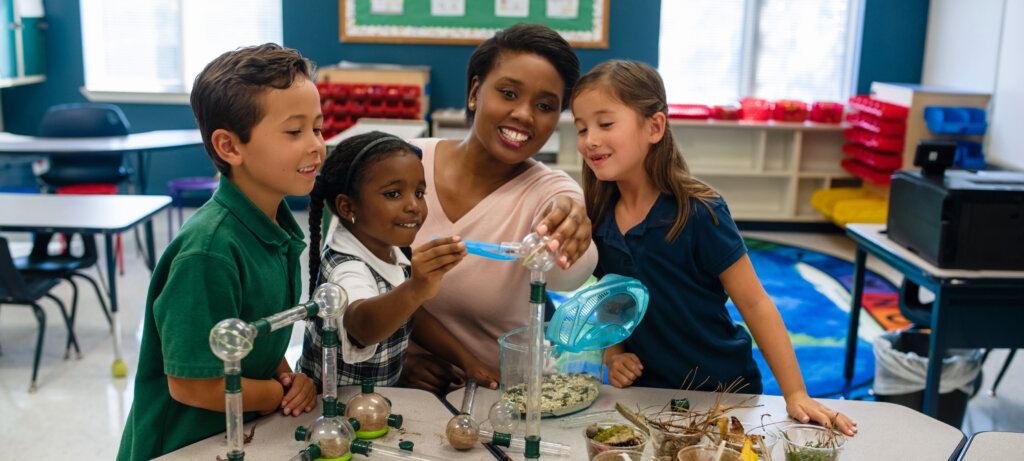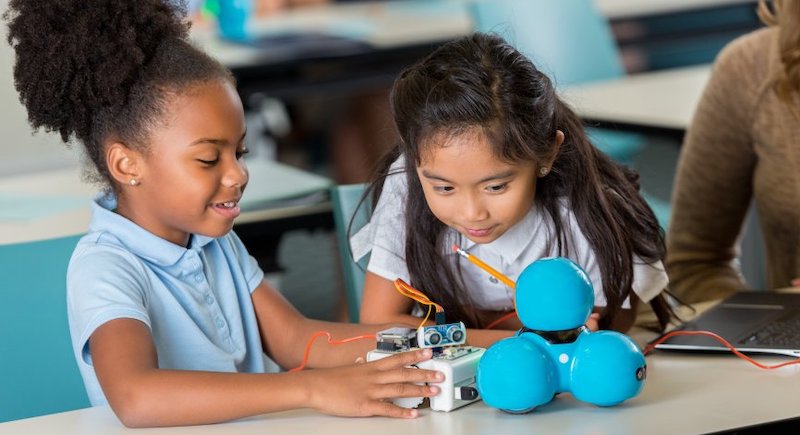STEM education—despite some challenges we're now facing—remains so important for the futures of so many students. We know that, within many schools, dedicated STEM teachers can help create real-world learning for students. In other schools, however, STEM learning experiences are more of an informal thing. There's nothing wrong with this but, a lot of the time, purposeful, routine-based STEM learning is far more impactful for students. While creating a school STEM program has some challenges, the rewards can be far greater. Plus, since STEM education is tied so closely to so many of today's most intriguing challenges, it's often easy to keep that momentum going once it's established.
Designing a Top-Tier STEM Program from the Start
While we don't want to put too much pressure on educators starting new STEM programs, there are some suggestions we can provide. The first of those, as with any new educational endeavor, is to decide on and clearly define the program's identity, purposes, and objectives. This often means figuring out how student learning experiences will reflect real-world problem solving. Of course, the learning experiences may need tweaks for kids in different grades and with different abilities, however. Typically led by a dedicated STEM teacher, school STEM programs are also effective when teachers connect them to students' other classes. With input from curriculum designers, STEM teachers can really help students make these connections.
Creating a STEM curriculum.
To that end, a huge factor in a successful STEM program is your curriculum. We'll use the term 'curriculum' loosely since the blueprint that STEM teachers follow in classrooms or makerspaces doesn't need anything official. Of course, this might be required if school or district leaders create any standards for their program but, if it's more of an informal class, teachers would still need a plan regardless. Essentially, it should be as rigorous as students can adapt to and as in-depth as school leaders permit. Also, their STEM projects and lessons often involve hands-on learning, meaning that it would be great to build into these lessons. Above all, the STEM curriculum should also feature real-world connections, opportunities for children to talk and collaborate, and relate back to the concepts they learn in their mainstream classes.
Learning elements to consider.
Next, and this might appear overly simple but, in STEM classes, it's key for teachers to really use STEAM-based instruction. There are many elements to STEM learning, which makes it easier to choose something or challenging to narrow things down. One potential strategy is to try project-based learning, which is great for defining problems, designing solutions, and promoting collaboration. When working as teams, students get to experience the benefits of collaboration and open communication. They can also learn how to share ideas and design solutions together—two key pieces of STEM. When laying the groundwork for the STEM program, including these key features can prove to be very helpful. At the same time, teachers should be prepared to adapt their approach if it's not effective enough for every student.
Strategies for Building Sustainable STEM Programs
From school to school and state to state, the resources available for launching school STEM initiatives will vary. Other things that will vary are the outcomes teachers consider to be successful. When creating a new STEM program, keep in mind these results are very much objective. Sure, you might see more engagement or notice stronger test scores among some student groups. Others, however, could still benefit, but in ways that are not necessarily measurable. Particularly for establishing a STEM program in elementary schools, the most important factor is student engagement. By creating fun opportunities for collaboration, problem solving, high-quality discovery, and building digital literacy skills, teachers can help the large numbers of young students who haven't previously enjoyed these experiences.
Designing equitable STEM programs.
In order to truly end up being successful, STEM programs must be equitable. Not every student has had the same personal and academic experiences and holding them to unrealistic expectations generally will not work well. Inequities in STEM most drastically affect underserved, vulnerable, and underrepresented students. If they're not taking part in a STEM program or fully engaging with all the learning opportunities, they're missing the chance to develop lifelong skills. In the elementary grades, in particular, STEM learning allows kids to explore creative problem solving, build self-confidence, and accomplish new things. That is, however, as long as they're inclusive for all students. When this occurs, educators are much more likely to see improvements in both academic and social competencies.
Who leads a new STEM program?
Aside from ensuring diversity and equity, school leaders need the right people leading the programs. We know that many educator roles have evolved over time and creating high-impact STEM learning is part of that. You'll need teachers trained in facilitating STEM opportunities, which will likely affect PD budgets and efforts. In the best STEM environments, however, students may receive instruction from teachers who have been recruited for that very purpose and also trained to deliver the best results. This is often more relevant in the upper grades but not necessarily reserved only for that time. If elementary administrators can bring in some trained STEAM instructors, then that's a fantastic start. Their experience and eye for innovation often helps even young students follow the right track to building STEM literacies.

Key Elements in a School STEM Program
In some schools, STEM initiatives are informal, light, and fun while, in others, they're a more rigorous part of the curriculum. Depending on your mission and resources, it's best to decide on a clear focus and goals when starting a new program and for each to be realistic and attainable. To maximize effectiveness, school leaders and STEM specialists must understand the origins of STEM learning and its importance in modern educational environments. The basis for starting a STEAM program may come from a classroom teacher, a school community member with experience in the STEM economy, talking with a business professional, or even something else. Whatever the reason, recognizing a call for more STEM opportunities is often reason enough to make that commitment.
Discovering your reasons for focusing on STEM.
Next, faculty members should work with the administrators to collectively generate an agreed-upon school STEM mission. It should also be relevant and attainable and include purposeful insights from all who would like to contribute. It doesn't have to happen overnight either and, oftentimes, the research and planning will help that mission come to light. To do this, it's often helpful to focus on why you are creating your program, why you are interested in providing STEM opportunities, and your instructional needs. Teachers could tap their networks for examples of successful STEM programs or talk with their colleagues. This can help them see how to replicate something successful, align it with their established goals, or discover new ideas.
Building a STEM program plan.
And, now for some additional tips on creating school STEM programs. Of course, it will be unique in every school, but some advice educators who have been there before share with those in the education world is applicable almost across the board. One of those tips is trying to incorporate STEM lessons in the existing curriculum. This allows teachers to highlight some key STEM-specific elements of learning without needing to create all new lessons and projects. Also, it's important to never associate STEAM learning with any age requirement. STEM is relevant for all students—now more so than ever. And, today's STEM tools, projects, and philosophies are relevant to even the youngest students. Finally, planning to integrate these new tools by reviewing the school budget helps things run more smoothly.
Logistical Considerations for your Program
Deciding on and defining a group mission are very important elements of school STEM programs in the long run. After all, this is how administrators can gauge the overall impact and success it's helped create. While educators should settle on these shared goals before actually launching the program, they typically won't be evaluating them right away. So, once the goals are set, the next thing they'll typically do is figure out some logistics. Depending on the scope of your STEM program, these will vary, too. Successful STEM programs are often those with a lot of balance. What we mean is that going too big might create unrealistic expectations and be tough to live up to while going too small may not allow you to reach your instructional goals. It's all about finding that sweet spot and going from there.
Size, space, and budget.
As for those logistics, it starts with figuring out the space and budget. In some cases, educators may host STEM programs in their existing classrooms but, in others, they may be creating a brand-new class, which would likely require a new room. Knowing the size of your space is important when it comes to deciding on EdTech and MakerEd tools. This is also, understandably, tied to your budgetary freedom. Once the STEM program budget is set, educators can research some resources that align with it. They don't all have to be physical resources, either. Digital tools, in the right situations, can be equally effective. Especially if these students have less physical space, smaller and, like we said, digital STEM tools are valuable. That's why knowing what the space will look like, including its size, is so key in new STEM initiatives.
How to capitalize on excitement.
Since STEM learning is so closely tied to community, educators should keep this in mind. If not taking place in an actual classroom, setting up STEM opportunities in a busy area is often exciting. This gives students a fun chance to show their projects off to other teachers, administrators, faculty members, and friends. It could also help inspire an increased spread of STEM activities around the school. Beyond that, if you are really willing to highlight student work, starting or finding community programs is a great option. Whether it's science fairs, STEM competitions, or community nights, many of them will enjoy showing off the fruits of their labor. Then, as time goes on, repeating what's worked and letting students participate in the same events will also help boost their agency and help the overall effectiveness of the program.

The Untraditional Approach to STEM Learning
To some teachers, the term 'STEM' simply refers to a more targeted way of teaching math and science. In our opinion, however, those subjects and learning opportunities already exist in most curricula. So, there's not much teachers can do to make them more hands-on, relevant, or collaborative. They can, however, try to supplement those subjects with STEM tools or create new classes built around today's STEAM learning. Also, when we say 'STEM tools,' it's a rather general reference. Basically, these include any hands-on tech tools from low to high-end whether it has a digital component or not. It might be 100 percent physical, 100 percent digital, or a combination of the two, which is most common. It's lessons and experiences centered on these tools that are typically ideal for getting students collaborating and thinking like innovators.
STEM experiences help drive preparation.
Much of the time, educators find success in creating a STEM program that's not connected to any existing curricula. Starting from scratch enables them to implement any new lessons they'd like—from 3D printing to robotics to engineering. Depending on students' ages, they can also use these academic experiences to help bolster their real-world readiness. When they're 3D printing, for example, students often need to utilize design thinking and collaborate with one another—a couple more hallmarks of real-world success. Also, for those students who may not intend to attend college, it's the perfect opportunity to boost their career and technical skills. The thing about this, however, is that it's often the STEM-related technology tools and the learning atmosphere that help prepare them regardless of their future plans.
Trying new things while sticking to goals.
These types of experiences also help drive student collaboration—a crucial soft skill. In fact, almost every experience students will have in STEM—regardless of grade levels—can potentially foster collaboration, teamwork, and an understanding of communal problem solving. As MakerEd, CTE, and even esports and VR continue to work their way into K-12 STEM programs, their impact on student development looks very promising. While these might not always work perfectly, they certainly have the potential to do so with the right approach. Keeping these tips as well as those you gain from fellow educators in mind can go a long way in maximizing the success of the program. Whatever you decide on for your goals and outcomes, be sure to stick to them and be willing to make adaptations. And, as always, feel free to reach out to us for guidance on starting or improving your STEM program.
For the latest EdTech, STEM, and 21st century education news, follow us on Twitter and Instagram. Like us on Facebook, too, or sign up for our newsletter for our latest product announcements and offerings. If you have an idea for an Eduporium Weekly theme, send us a message on social media or comment below.



